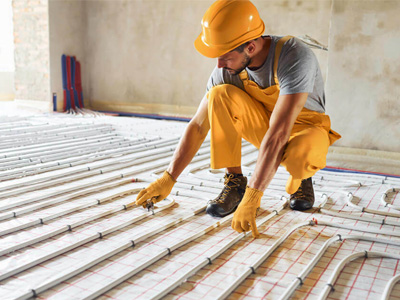Electric Underfloor Heating.
Electric underfloor heating is available as either a heated mat or a heating cable-based system, both convert electric energy into radiant warmth. Heating mats use ultra-thin electric heating wires pre-attached to a ready-sized mat which can simply be rolled out and adhered to the subfloor. Heating cables take the form of a free-form electric wire which can be directly installed onto or within the subfloor.
If you are working on a renovation project, electric underfloor heating may be more suitable as it does not significantly increase the floor height. The Loose Wire System features a 1.8mm heating cable which can be fitted within a layer of levelling compound or adhesive and so has no effect on floor build-up. Electric systems are also preferable if you’re installing a heating system in just one or two rooms.
Electric systems are perfect for use as primary heat sources in small rooms such as bathrooms or as secondary heat sources in larger spaces. Heating a large area with electric underfloor heating may not be desirable, as energy-efficiency is achieved in large areas with water underfloor heating used with an air or ground source heat pump. That said, you should always conduct a heat loss calculation and choose an underfloor heating system that provides more heat output than the maximum heat loss. However, installing high-quality floor insulation with an electric heater greatly enhances the efficiency of the system and aids in reducing heat-loss.
Due to current energy tariffs, the cost of running an electric floor heater will be slightly higher than a water system but you can expect to pay from as little as £1 per week to heat your bathroom.
Electric systems offer rapid installations times with some products being able to be installed in under 30 minutes. Electric heaters utilise a wide range of installation techniques including self-adhesive backing
Electric floor heaters provide great value for money. Installing our Loose Wire System in a 4m² bathroom with accompanying insulation and a thermostat would be approximately £450 + VAT RRP.
Wet Underfloor Heating
Water systems, also known as hydronic underfloor heating or wet floor heating, involve pumping water, heated to an optimal temperature by a heat source (a traditional boiler or heat-pump) through underfloor heating pipes, also known as circuits, which are laid within or on top of the subfloor beneath your floor finish.
Water systems are typically recommended for new-build projects where the system will be the primary source of heat throughout the house. Most systems require installation within a thick layer of screed leading to a greater system depth compared to electric heaters however there are low-profile hydronic systems available.
Water based underfloor heating is generally recommended for installation on the ground floor of a project with good insulation or a system such as the Hetta wet underfloor heating system is ideal for use over battened or suspended timber floors on upper levels. If you’re renovating and using a low-profile system, it may be difficult to reach enough heat output from a low build water-based system if the subfloor is not sufficiently insulated.
Hydronic heating systems provide lower long-term running costs compared to electric systems and using a more efficient heating source such as an air source heat-pump can bring even greater savings. Controlling an underfloor heating system with a Smart Thermostat also unlocks even bigger savings on your energy bills.
Water systems often take longer to install than electric systems, with time needed to test the system, the flow and pressure of the water and, in the case of ‘wet’ installations, waiting for the layer of screed to dry before installing your floor finish.
Hydronic systems are more expensive to install but cheaper to run in the long-term. If you’re thinking about specifying a water system, get in touch with get in touch with your local plumber who will be able to assist you in designing a bespoke system fit for your home
Conclusions
Both electric and wet systems have their benefits, and it will entirely depend on your home, needs and situation as to which will be the better option. If you are stuck for choice, we recommend speaking to your local plumber who will be able to give you advise on which option will be best for you.

